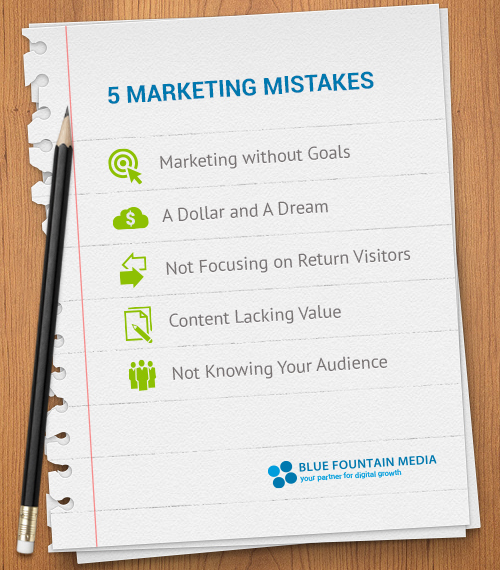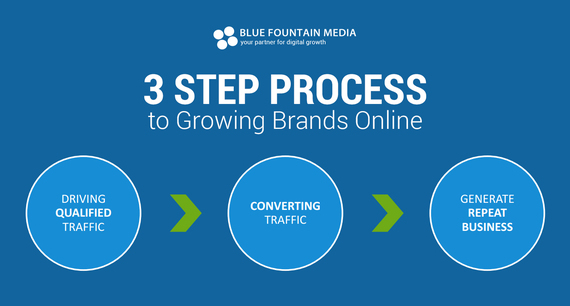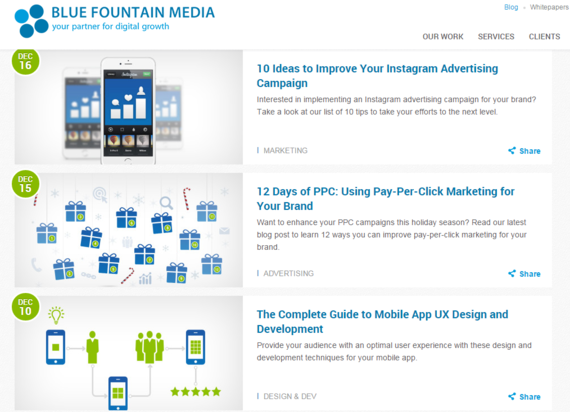Marketing mistakes can be incredibly costly. From missed opportunities because of failing to reach your audience, to a decrease in sales that your competitor captured instead, unsuccessful tactics that impact how you communicate your value to users can be detrimental to brand growth. More often than not, you'll hear about how to practice digital marketing the right way--but it's important to examine how things are done incorrectly as well so that you can learn from the errors of poorly executed marketing strategies. 
To generate the results that you're seeking for your organization, it's essential to proactively monitor performance across different channels and platforms so that you can discover areas of improvement. Take a look at five of the most common marketing mistakes below to understand what you should be avoiding, or what changes you should make today to improve the effectiveness of your brand's marketing:
Mistake 1: Marketing Without Goals
Nothing is more disappointing than when a client comes to our agency and says that they need to focus on a specific marketing channel, yet they have no plan or strategy to back it up. How do you start marketing without knowing what your milestones and goals should be?
If you fail to identify what you'd like to accomplish with a certain marketing campaign, you can't measure effectiveness and hold any specific tactic accountable for results. Perhaps the channel you're focusing on has brought you 20 extra leads in a month. How can you tell if that is the best performance possible? Without a strategy that identifies past performance and outlines objectives, there is no way to accurately develop a plan that allows you to reach the goals you've set.
Mistake 2: A Dollar and A Dream
In order to make money, you have to spend money. There is something called a loss leader, which is when you lose money in order to acquire a first time customer, however over time that individual customer eventually enables you to generate a profit. Most successful companies understand this, however a lot of new companies don't. Not grasping this concept can be the major downfall for a lot of brands. 
It's important to understand that whatever products or services you sell, for every dollar you spend, you won't get a complete return right away. Marketing investments take time. In fact, the buying cycle for each company varies. For most B2Bs the buying cycle could be anywhere from 6 months to 2 years, and for a B2C the product cycle could range from a single day to a 1-3 month period.
Mistake 3: Not Focusing On Return Visitors
Don't expect to have immediate profitability. Most first time visitors don't convert on an e-commerce site. Repeat visitors almost always convert at a higher rate than first time visitors. So, you want to use a combination of channels and tactics to bring users back to your website. 
Email marketing is often employed for bringing visitors back to your site. Once you capture a user's email, you can send them high-quality content with some sort of incentive or perk that consumers will find valuable and appealing. Targeting users that have already visited your site through retargeting ads allows your brand to stay top of mind and encourage those potential-customers to click through to your site. Simply relying on traditional PPC ads won't bring back second-time visitors, but pairing that tactic with retargeting ads can do a terrific job at garnering repeat website traffic.
Mistake 4: Content Lacking Value
Show your value to your customers through your expertise. Users want to invest their time and money with your brand because you're knowledgeable in a specific industry. If you don't provide them with the content to showcase that, they won't see your value. To create valuable content, focus on the needs of your users and what they're trying to learn. Include vibrant imagery such as an infographic to help reinforce your messaging without overwhelming the reader with too much text. Incorporate quantitative data like relevant statistics to help substantiate any statements or thoughts you're making, because, in general, fact-based findings perform quite well. Anything you can do to help your content gain traction with your audience without sacrificing value will help your content serve a true purpose.
Content is king--especially if it is unique and high-quality. Search engines like this type of content, and it helps your rankings. Users like this type of content, and they will share it. Low-quality content diminishes your brand image and gives potential customers a poor impression of your company. At our agency, we share all of expertise through our blog and have garnered a significant following because of that. This has helped us to grow immensely as an organization by presenting our employees as thought leaders, improving our brand recognition, and increasing the amount of users that visit our site each month. Ultimately, those results have also played a major role in improving the performance of our lead generation efforts.
Mistake 5: Not Knowing Your Audience
Too often, you'll hear start-ups claim they have the best of the best product, and that it's for everyone. In general, products or services shouldn't be designed for everyone--they should fulfil a unique need to a very specific audience. Aside from that, chances are that unless you're a Fortune 500 company, you're not going to have the finances to market to "everyone" correctly.
Not understanding who your real audience is serves as a signal that you don't know the true value of your product or service. If you think that everyone can use what your brand offers, than you probably haven't done your due diligence to identify who your target consumer is, and you likely don't have a strategy aligned either. You're setting yourself up for failure.
Know who your market is--the more niche, the greater your chances are for success. It's better to target a very narrow demographic of users you know how to reach and whose behavior and interests you understand, rather than going after everyone under the sun.
The Right Marketing for Your Brand
Marketing mistakes can be costly on so many different levels. From financial losses to missed opportunities, if you're trying to grow your brand, you really can't afford to make these common mistakes. Take the time to really understand your company, the unique need it fills for customers, and then as a starting point, develop the right strategy that will help ensure your success. For more information on marketing strategies and tactics, visit our blog.
